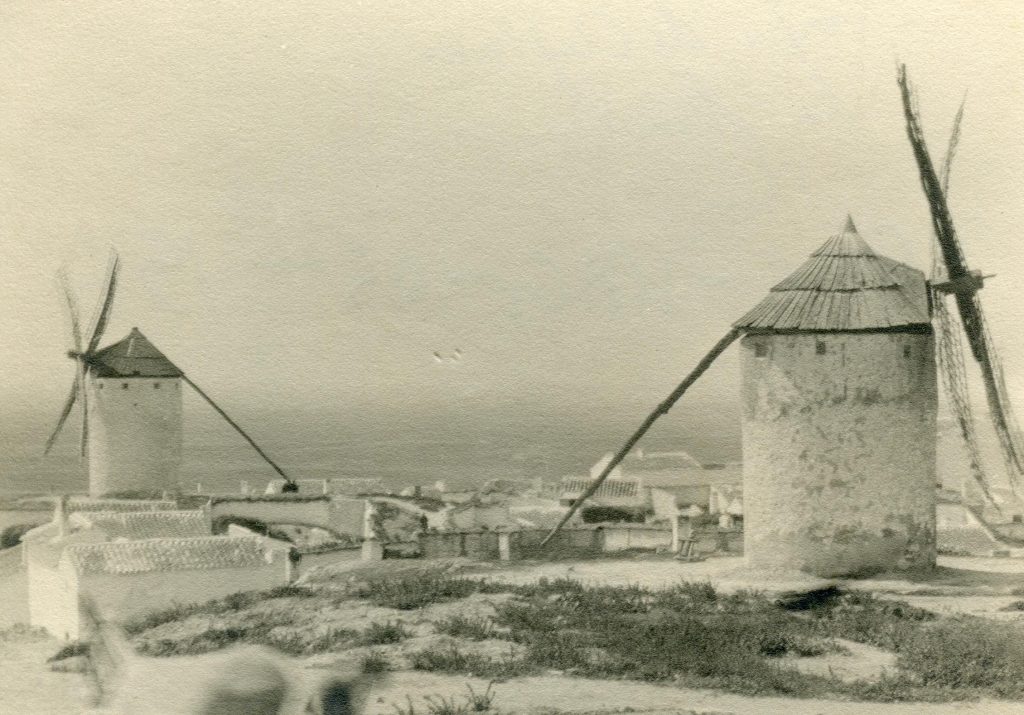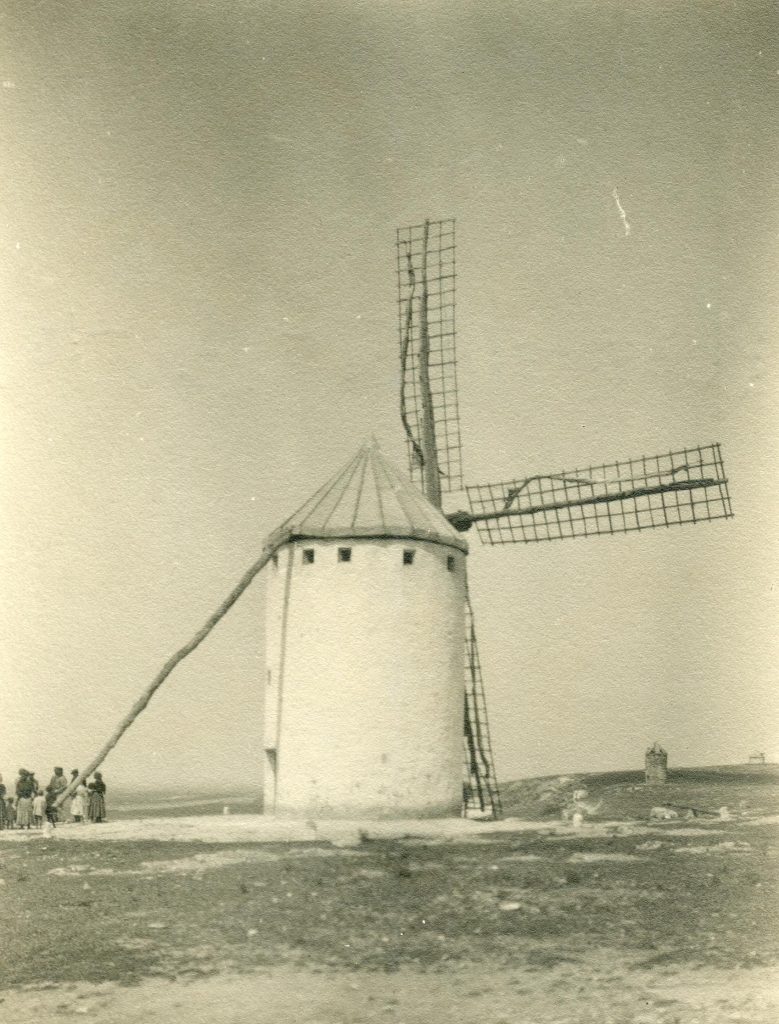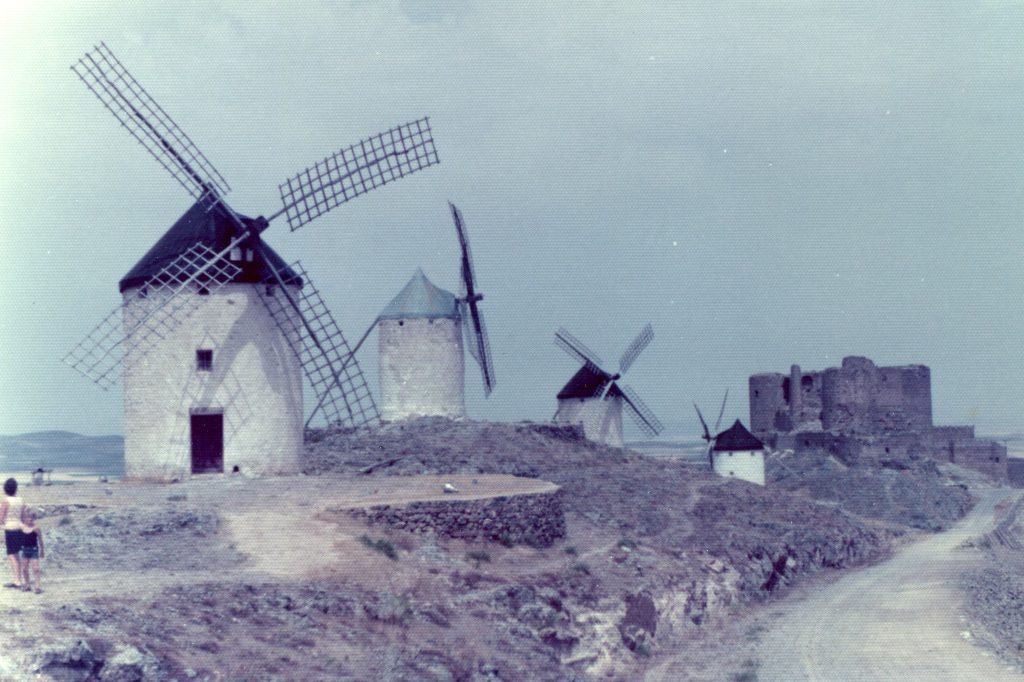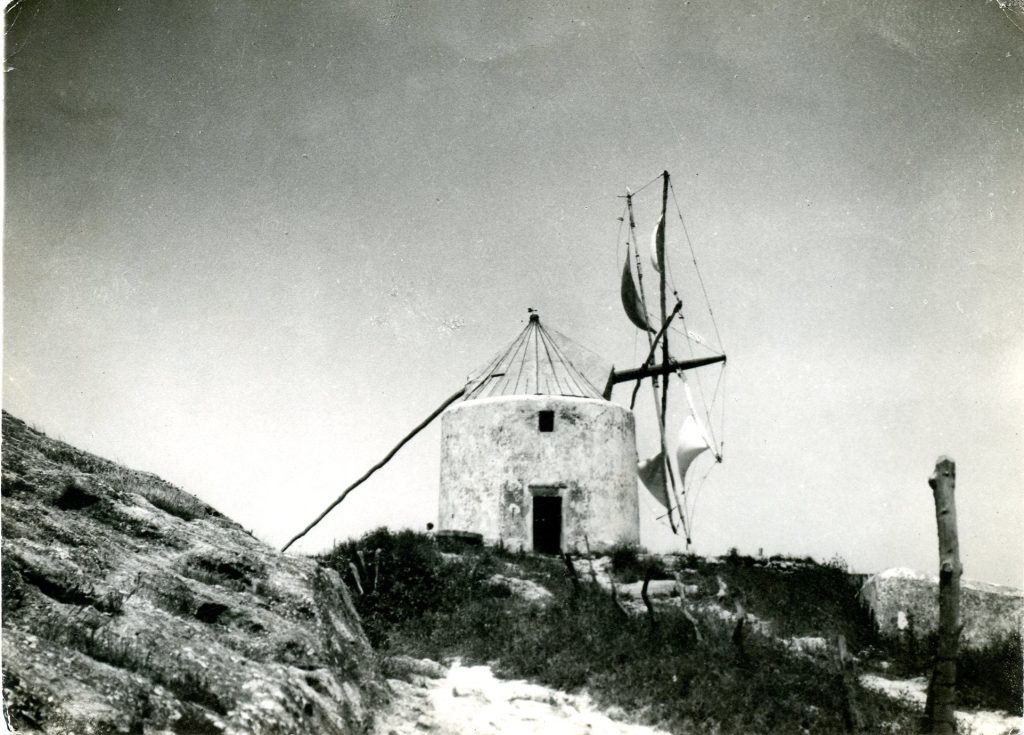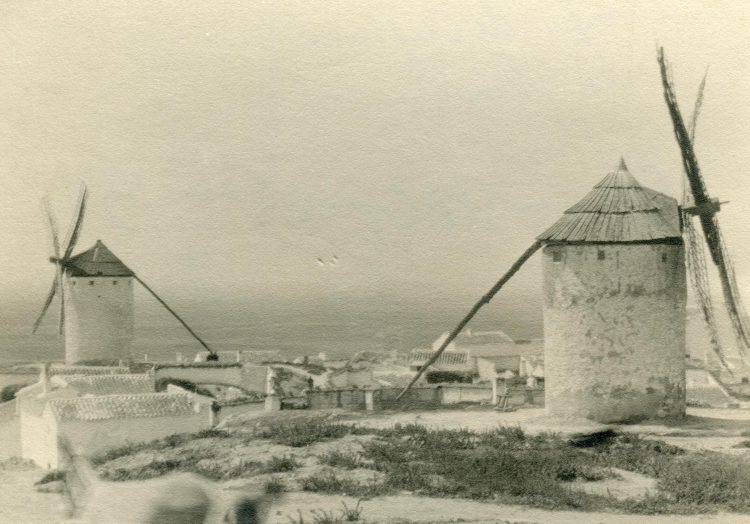
Rex Wailes
Some time in the 1950s or 60s, Rex Wailes visited Spain and toured the mills of La Mancha, famous for their appearance in Don Quixote. He wrote this account of his findings.
Mills of La Mancha
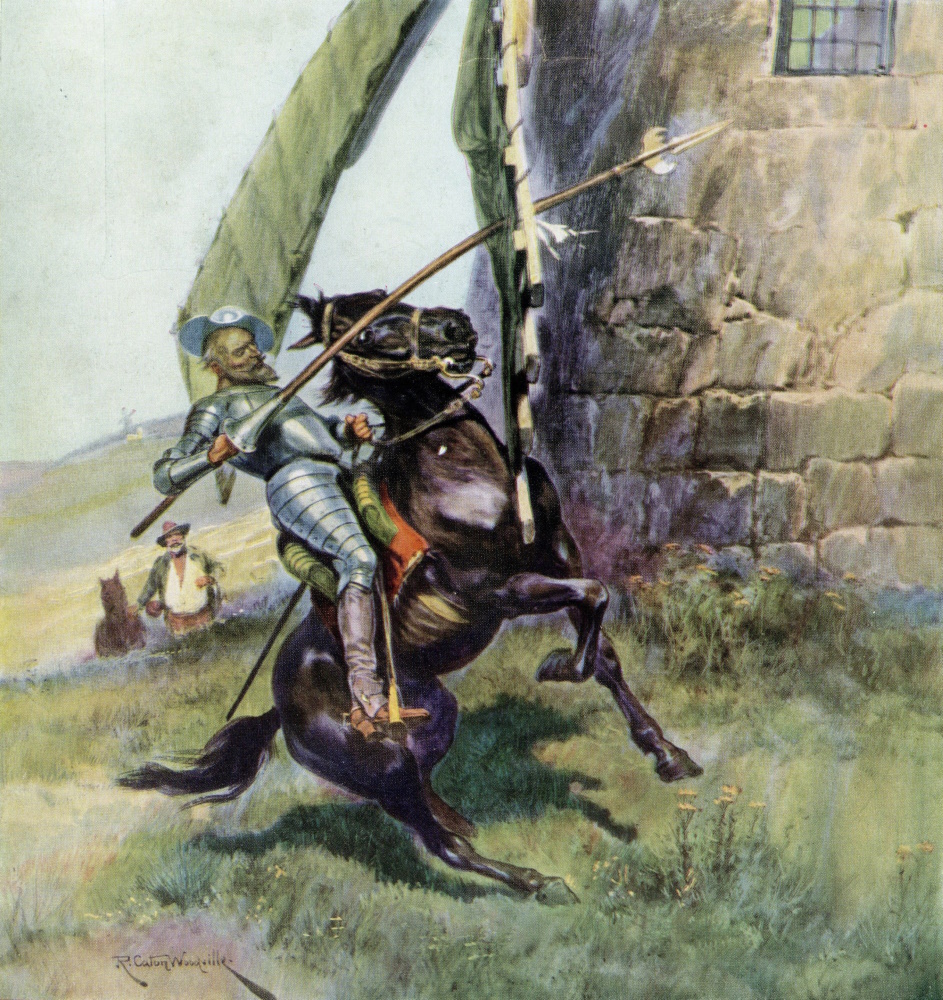
Don Quixote, from the cover of the Northwestern Miller, Janyary 7, 1925
| At the same time the wind rising, the mill-sails began to move, which, when Don Quixote spied, “Base miscreants,” cried he, “though you move your arms more than the giant Briareus, you shall pay for your arrogance”. He most devoutly recommended himself to his Lady Dulcinea, imploring her assistance in this perilous adventure; and so covering himself with his shield, and couching his lance, he rushed with Rozinante’s utmost speed upon the first windmill he could come at, and running his lance into the sail, the wind whirled it about with such swiftness, that the rapidity of the motion presently broke the lance into shivers, and hurled away both knight and horse with it, till down he fell, rolling a good way off in the field. Sancho Panza ran as fast as his ass could drive to help his master, whom he found lying, and not able to stir. “Did not I give your worship fair warning?” cried he; “did not I tell you they were windmills, and that nobody could think otherwise, unless he had also windmills in his head?” Everyone who has read Don Quixote, and many who have not will recall the adventure of the windmills, and therefore will be aware that windmills existed in Spain. With the exception of those in the Balearic Islands, however, very little seems to be known about Spanish Windmills even in Spain itself. There appear to be three main districts in Spain where windmills are to be found, in La Mancha, the Don Quixote country; near Cartagena, on the south-east coast; and round Vejer, a small village in the south between Cadiz and Gibraltar. |
Mills of Campo de Criptana, La Mancha, Spain. Photo by Rex Wailes
(Mills Archive Collection, REXW-IMG-05-156)
| Señor E M Fraile, of Madrid, gave me information and photographs of the windmills of La Mancha, and during a visit to Spain in May he took me for a motor tour of the Don Quixote country. La Mancha is a flat brown richly cultivated plain south of Madrid, intersected by long straight roads almost treeless, without rivers, and stretching as far as the eye can see. The country folk live in small white villages and towns and go out to work on donkeys or mules in blue smocks and berets every day of the week. At occasional intervals are outcrops of rock rising to perhaps 100 feet above the general level of the plain, and should there happen to be a town or village at the bottom one finds windmills on the top, a few still at work, but the majority derelict. Such is the mill which is supposed to be the scene of Don Quixote’s famous exploit; it stands above Villa Cañas and is called “El Gallo” (The Cock); it has not sails or machinery but is the property of the Sociedad Cervantina (Cervantian Society) named after Cervantes, the author of Don Quixote, and by them it has been turned into a library of the works of Cervantes and material relating to him. |
One of the Campo de Criptana mills. Photo by Rex Wailes
(Mills Archive Collection, REXW-IMG-05-107)
| Further south at Campo de Criptana is the biggest group of mills; here are four at work and as many derelict, perched up above the white-washed town on the usual rock, which seems to be common land. They appear to be precisely similar to all others that we saw in La Mancha, and I understand that this is so, only small details varying. Two mills standing next to each other were examined, one called “El Infanta” (The Princess) was built in 1780, the other called “Burleta” (Wind Stopper) was built in 1889, yet neither was different from the other in any important detail. The tower (castillejo) is of local stone with plaster (tabique) inside, whitewashed inside and out, and with its stone floors is a model of cleanliness. |
These towers are about 17ft diameter inside and either parallel, or with a slight inverted batter, i.e. the tower larger at the top than at the bottom. The cap (caperuza) is conical and covered with three overlapping layers of boarding and in some cases zinc has been substituted for the boards. The cap has a dead curb running wood to wood and is turned by means of a tail-pole (gobierno), a rough tree trunk which is let in and lashed to the king post (fraile) of the cap; a winch (borriquillo – little donkey) is used to haul round the tail pole.
There are four double common sails (velas), the bars (teleras) being fixed on either side of the whips and the cloths set in the usual way. The whips are made of rough sapling trunks, with no attempt at trimming. They are held by a stock, a clamp behind each, both of which are of rough untrimmed wood and pass right through the windshaft; this is of pine, and is about 19” square at the brake wheel.
Mill at Valdepenas, La Mancha. Photo by Guy Blythman, 1975 (Mills Archive Collection, GUYB-FW2-079)
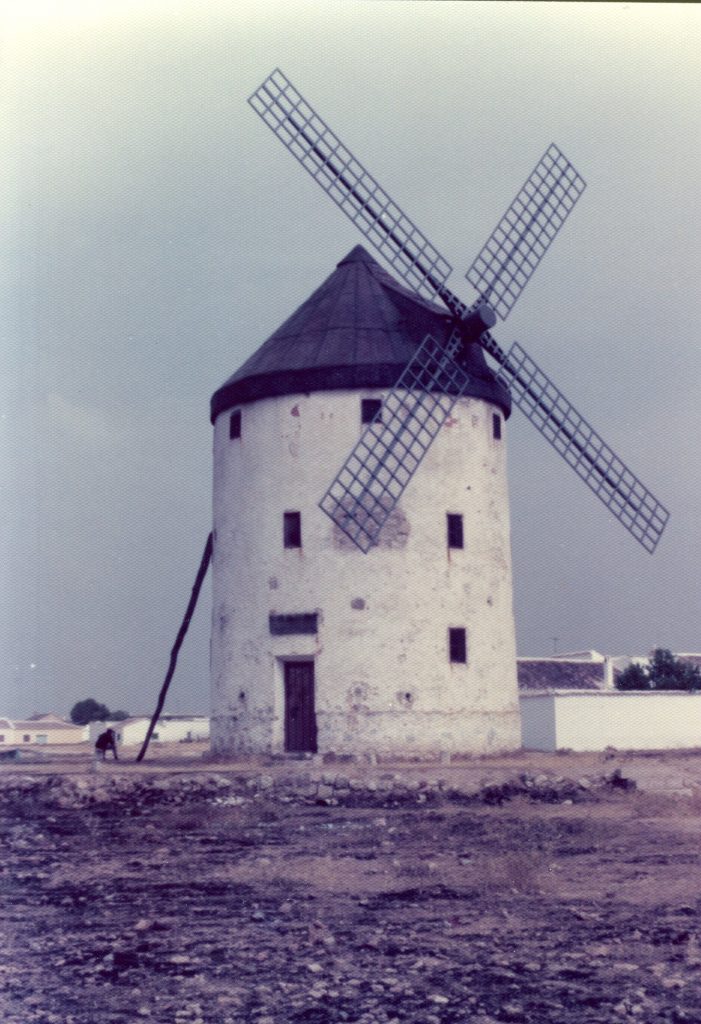
Preserved tower mills at La Mancha, Spain. Photo by Guy Blythman, summer 1975
(Mills Archive Collection, GUYB-FW2-078)
| The stones are mounted on a brick hurst and have either a wood casing (cajon) or a casing of straw-plait matting (redor), but in neither case is the top covered in. Those seen were French stones built up of five pieces and about 5 ft diameter; the runner stone is called the “volandera”, and the bedstone the “solera”. Grain is carried up to the hopper (tolva) in plated straw baskets about the size and shape of a carpenter’s tool bag. Twelve small windows in the wall about 12 ins square, just below the curb, light the top floor, which, besides the stones, contains a modern sifter driven by belt from a wood pulley mounted directly under the lantern pinion. The tower contains two floors and a mezzanine floor and communication is by a single stone stair; the ground floor contains only the meal and spout and sacks and is lighted by the doorway; the mezzanine floor contains a modern boulter (cernador). |
Mills of Vejer
| Vejer is on top of one of the hills that lie roughly behind Cape Trafalgar; the hill of Vejer is some 300 ft above the main road, which runs through a well wooded valley at this point. The town is approached by a zig-zagging road having about 18 hairpin bends, the slope of the hill being almost precipitous; it has a somewhat broken top, where four mills are still at work, while as many more are derelict. |
Molino Catalina, Vejer de la Frontera, Spain. Photo by Rex Wailes
(Mills Archive Collection, REXW-IMG-05-209)
| Although very different from the mills of La Mancha, they are all alike varying only in small details; one mill examined called “Catalina” is undoubtedly of considerable age, yet it scarcely differs from another called “San Francisco” built in 1863. The tower is built of stone plastered and white-washed, about 14 ft diameter inside, with walls about 4ft 6” thick. There are but two floors connected by a stone stair; the ground floor consists of two substantial parallel arches, with two doorways in between them and opposite one another. The cap is conical with gables for the windshaft and tailpole and is thatched, zinc having been substituted for the thatch in the case of most of the working mills. The cap is turned on an iron faced dead curb by means of a tailpoile, a rope and blocks being used instead of a winch for hauling it round. |
Jib sails are used similar to those found in Portugal and the Mediterranean islands; there are eight poles, but only four sails were being used at the time of my visit as the wind was very strong. The sail itself is wrapped round one pole, and the end of the jib is attached to the nest one.
The poles are braced to a kind of bowsprit projecting from the front of the windshaft, and when at rest the lowest one is anchored to one of a number of rings fixed low down on the outside of the tower for that purpose. I am inclined to think that this type of sail is not the ancestor of the ordinary common sail, but an independent development on the part of men used to sailing ships, for none of this type of sail is found very far away from the sea.
The stones are of local grit and are about 5ft diameter. The thickness of the walls is so great that many recesses are formed in them for use as cupboards, and in one of these on the stone floor was one of the miller’s hens sitting on a clutch of eggs.
Jib sails of old mill, Vejer de la Frontera, Spain. Photo by Rex Wailes, 1960s (Mills Archive Collection,
REXW-IMG-05-112)
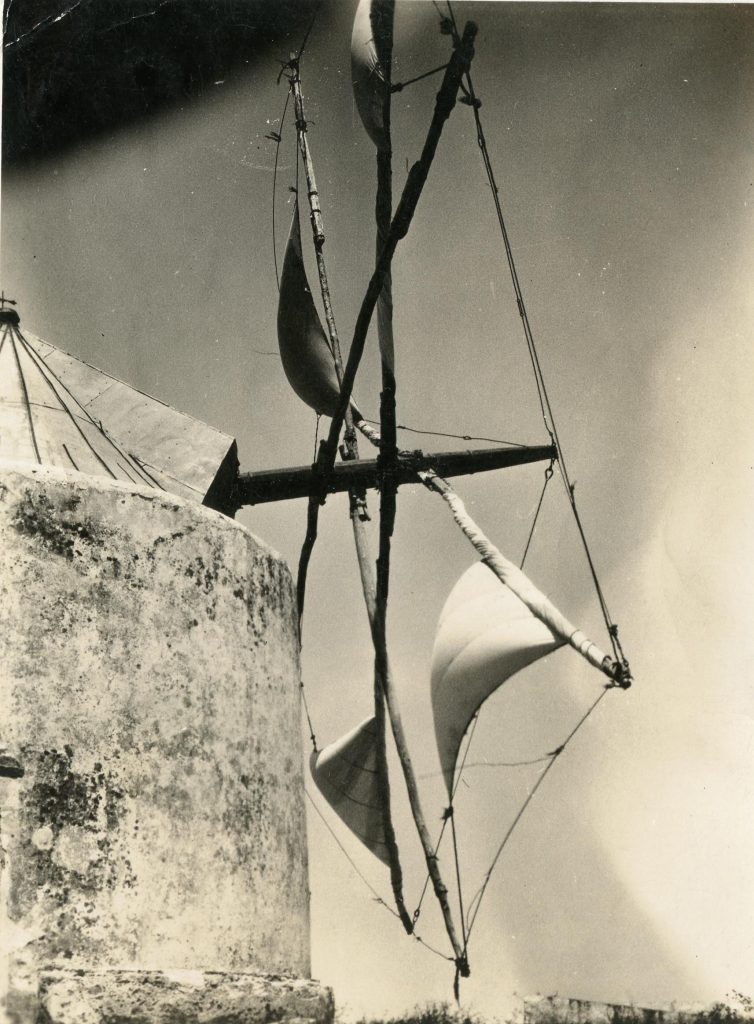
| I understand that there are no post or smock mills in Spain and it is an interesting speculation as to how the existing mills evolved. They may conceivably be descended from those of France, but as yet no one has given us a convincing theory as to their origin. |
